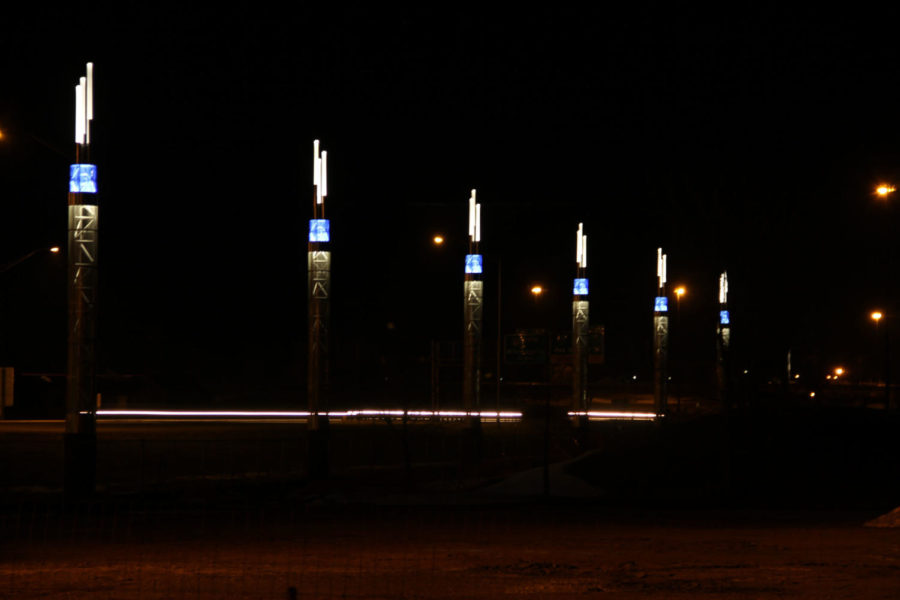Team spruces up Ames’ Southeast entryway
January 15, 2013
Entry into Ames is now a lot more colorful and scenic for travelers entering Ames via U.S. 30 or I-35 from the east. Light columns and foliage on U.S. 30 between the I-35 and South Dayton Avenue interchanges now guide travelers into Ames.
The Southeast Entryway project, which took more than a decade to come to fruition, was created to make the entryway more noticeable and attractive. The project began after the South Ames Business Neighborhood approached the city to make the southeast entryway into Ames more functional and beautiful.
Monte Parrish, owner of Iowa House Hotel and Microtel Inn and Suites and member of the South Ames Business Neighborhood, said the area near Ames’ southeast entryway seemed neglected when he arrived in Ames in the 1980s. He cited Ames’ land use policy plan published in 1997 and explained how he wanted to implement some of the plan’s ideas.
In the plan’s portion on entries into the city, it states entries “should be well identified and designed in accentuating access to the major areas and activity centers.”
Parrish said he believed some travelers on I-35 may not have noticed Ames in the past because of the lackluster appearance of the city’s southeast entrance. Pat Brown, president of the South Ames Business Neighborhood, agreed, stating the southeast entrance into Ames was “not very inspiring.”
“I mean, it looks like nothing,” Brown said, describing the southeast entrance into Ames prior to the completion of the project. “Why would you even stop? There’s nothing to make it look like there is something there.”
Brown said a city’s entryway says a lot about residents’ pride in their city. Additionally, she said a city’s entrances should attract new businesses as well as shoppers to come to the city.
“People like to shop where people care about the place — what businesses look like, what the landscaping looks like,” Brown said. “It’s subtle. People aren’t aware of their positive reaction or why they are that way.”
Parrish also described how South 16th Street remained unpaved for several years, causing problems for the hotels on the street.
“It wasn’t unusual to have shuttles running to various hotels [on Southeast 16th Street,]” Parrish said. “It was just kind of dysfunctional the way the road wasn’t developed.”
Believing there was a need to improve the Southeast entryway, the South Ames Business Neighborhood approached the city council for assistance. At that time, Jeff Benson, an Ames city planner, became involved and told the group a consultant needed to be hired to make a plan for the area.
The South Ames Business Neighborhood paid for the design consultant, Dunbar-Jones PLC, to do a study to engage stakeholders and identify opportunities to improve the entryway. Benson praised the involvement of the South Ames Business Neighborhood members, stating the project would not have happened without their help.
“The first thing that was remarkable was the property and business owners [in South Ames] started the whole planning process and asked the city to implement its plans in the area,” Benson said. “Secondly, that they were willing to pay for the initial design consultant, which was kind of unusual.”
Benson said the first phase of the project involved the planting of prairie plants and trees and the paving of Southeast 16th Street, which was completed and opened to the public in May 2008. Benson said, by that time, the South Ames property owners had donated more than $50,000 and contractors had donated “several hundreds of thousands of dollars in labor and supplies” to the project.
“It became apparent after the initial pilot project that it was going to take a lot of money to do anything that would have an impact and doing it in little pieces probably wouldn’t do,” Benson said. “So we applied for a transportation enhancement grant from the Iowa DOT.”
In February 2007, the Iowa Department of Transportation approved a $685,000 transportation enhancement grant for the Southeast Entryway project. Benson explained the grant helped pay for the light columns as well as prairie plants and trees.
“It gives a message that our community is a community that is forward thinking and is interested in technology and art, but is also situated in a natural environment and values the natural environment it is in,” Benson said.
The light columns were designed by a team at RDG Planning and Design Dahlquist Art Studio. Artist David Dahlquist said he and the rest of the design team worked with Central Lighting and Equipment to design light columns with LED lights that could be programmed to change color.
The process to make Ames’ Southeast entrance more beautiful and functional has been a long one, especially to those who have been involved with the project since its inception. Those involved attributed the success of the project to the team’s determination.
“We stayed determined, followed our noses, stumbled around a bit… and about 12 or 13 years later, we got it done,” Parrish said.

















